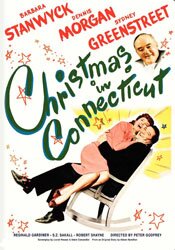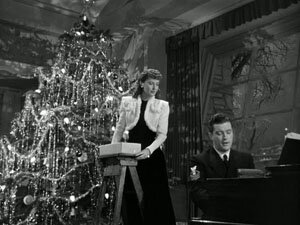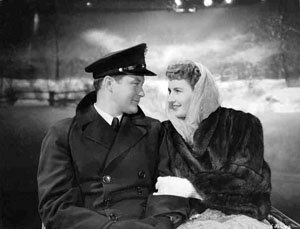Eddie Bracken just looks funny. It’s not in a physically distorted way; it has something to do with the innocent, cherubic quality of his face that makes you smile. And when he starts moving? You start to laugh.
Playing it straight: The Lady Eve
I foolishly put a poll on Facebook asking people what movie they felt was Preston Sturges’ best. It was foolish because I used the word “best” when I should have used “favourite” or some other word. How can you pick a “best” Sturges when there are a fistful of movies that could vie for the top with legitimacy? However … as it turns out, though a very small sampling, tied at the top of the results were Sullivan’s Travels and …
Continue reading
Barbara Stanwyck must have liked working
Without intending to, I’ve found myself watching a lot of Barbara Stanwyck movies lately, including Double Indemnity (of which I’d like to scribble something one of these days). I believe IMDb shows she appeared in 101 movies and TV shows in her career. She really must have liked working.
I realized I have 18 Stanwyck movies on DVD (only a small number relative to her output). Of those, I’ve watched 15. There are three I’ve yet to see (but plan to): To Please a Lady, Jeopardy and Stella Dallas. Of the 15 watched, I’ve only written about a few, such as this one below. I watched it just last week.
My Reputation (1946)
Directed by Curtis Bernhardt
It seems a strange thing to say but My Reputation suffers from an actor’s performance that is too good.
Barbara Stanwyck portrays Jessica Drummond so well, you almost fume with frustration with her in the movie’s first half.
That’s not actually the case, however.
The problem is the movie and using its first third to create a portrait of a conflicted woman – it’s really a lot of exposition. As the Variety review from 1945 points out, the movie’s other star, George Brent, doesn’t make an appearance for about a half hour or so.
My Reputation is a romantic melodrama and, once the first third is over and certain things are established, entertaining in an average kind of way. Actually, thanks to Stanwyck’s performance, it’s above average. While a romance, it is also about psychological conflict and it’s that element where Stanwyck really excels.
Jessica Drummond is a recent widow who suffers from a domineering mother and friends who are superficial at best. She wants to assert herself as an individual, having been lost for years as secondary to others, but she can’t bring herself to do so. She makes a number of false starts.
This is what I mean about frustration: Stanwyck portrays the conflict so well that, if you are me, while sympathetic you want to tear your hair out because she is so mousy. However, once a new love shows up in the form of George Brent as Major Scott Landis the movie picks up as Stanwyck’s character becomes increasingly stronger.
It’s true the movie is dated, as some have pointed out, but I didn’t find that a particularly difficult barrier to get past, no more so than a historical film or book would be. It’s not a movie for everyone – despite the psychological aspect, it’s essentially a love story, a romantic fantasy.
If you don’t like romances, you probably won’t like this movie. On the other hand, if you want to see yet another brilliant Barbara Stanwyck performance, you really shouldn’t miss this one.
Blogathon Update:
- Self-Styled Siren has an update on the For the Love of Film (Noir) blogathon, including a specifically for the blogathon. Get ready! It begins Valentine’s Day (February 14) and runs through till February 21. Oddles of bloggers talking about film noir and film preservation.
Christmas in Connecticut almost great
Some movies leave you scratching your head, like Christmas in Connecticut. You like it yet it bugs you. Why is that?
This is another one of those movies I saw years ago as a kid watching TV in the basement. The DVD came out in 2005 and I recall watching it then but feeling ambivalent about it. I suppose I still do, though I liked it much more when I watched it last night. But that opening …
 Christmas in Connecticut (1945)
Christmas in Connecticut (1945)
Directed by Peter Godfrey
This movie is an odd duck. It’s a good, quick paced Christmas movie of the old Hollywood variety, as in circa the 1940s (which is when it was made). Christmas in Connecticut has all the appearance of what we usually mean by a holiday classic. But it has some peculiarities and they are probably the reason it doesn’t quite achieve that status – though it comes close.
The first and most pronounced peculiarity is its opening. The first twenty or thirty minutes of the film are completely unnecessary and also suggest a different movie than the one we end up seeing. The movie is also a lot more interesting once that opening is over.
For some reason, perhaps length or a script change elsewhere in the film, the opening appears to be tacked on to what seems like a finished movie. Jefferson Jones, played by Dennis Morgan, is a war veteran in a hospital having survived being adrift at sea. He’s absolutely obsessed with food. This sort of sets up the movie that follows, except once that movie starts his food obsession seems to mysteriously vanish.
Food is at the heart of this romantic-comedy in the sense that it is one of the defining characteristics of Barbara Stanwyck’s character, Elizabeth Lee. She’s a kind of war time Martha Stewart, a famous master of country kitchens and homes, known as the world’s best cook. She writes for a magazine about her beautiful country home and describes the fabulous foods she prepares.
 Except she’s a city apartment dweller and doesn’t know the first thing about cooking. The complication comes when her publisher, Sydney Greenstreet as Alexander Yardley, decides to invite himself and the war hero to Christmas at her home.
Except she’s a city apartment dweller and doesn’t know the first thing about cooking. The complication comes when her publisher, Sydney Greenstreet as Alexander Yardley, decides to invite himself and the war hero to Christmas at her home.
Chaos follows. There are also numerous complications, not the least of which is the need to have a husband and baby because Elizabeth Lee writes about them all the time.
It’s also quite funny, especially when Greenstreet’s Yardley sees one baby on one day and another on the next and can’t understand why it looks different, has a gender change, suddenly has teeth and can talk. “Most peculiar,” he says.
The romantic aspect is with Stanwyck’s character agreeing to marry her insistent fiancé (whom she doesn’t love) in return for providing her with a Connecticut country home to use to fool Yardley. The romance comes in when she falls in love with Jefferson, the war hero.
 I also found some of the characterizations in the movie a bit peculiar, though not necessarily in a bad way. They just seemed odd. As mentioned, there is a food obsessed war hero who seems to forget his obsession once the real movie starts. Then there is Stanwyck’s Elizabeth Lee who appears to be completely self-centred and indulgent – yet we like her.
I also found some of the characterizations in the movie a bit peculiar, though not necessarily in a bad way. They just seemed odd. As mentioned, there is a food obsessed war hero who seems to forget his obsession once the real movie starts. Then there is Stanwyck’s Elizabeth Lee who appears to be completely self-centred and indulgent – yet we like her.
Despite the quibbles, I really did like this movie, especially once that opening was over. It certainly has the look and feel of a Hollywood holiday classic. It’s also funny and, in its Hollywood way, romantic. It gets great supporting performances, particularly those of Greenstreet, S.Z. Sakall (as the real food master) and Una O’Connor with her thick Irish accent and wonderful reactions.
For me, this movie played well – quick, engaging and almost, but not quite, satisfying. Had a bit of time been taken editing the opening, I would say it would be up there with the great holiday movies.
And I’m darned curious about how that opening came about.
On Amazon:
- Christmas in Connecticut (1945) — Video on Demand
- Christmas in Connecticut (1945) — DVD — Amazon.com (U.S.)
- Christmas in Connecticut (1945) — DVD — Amazon.ca (Canada)


